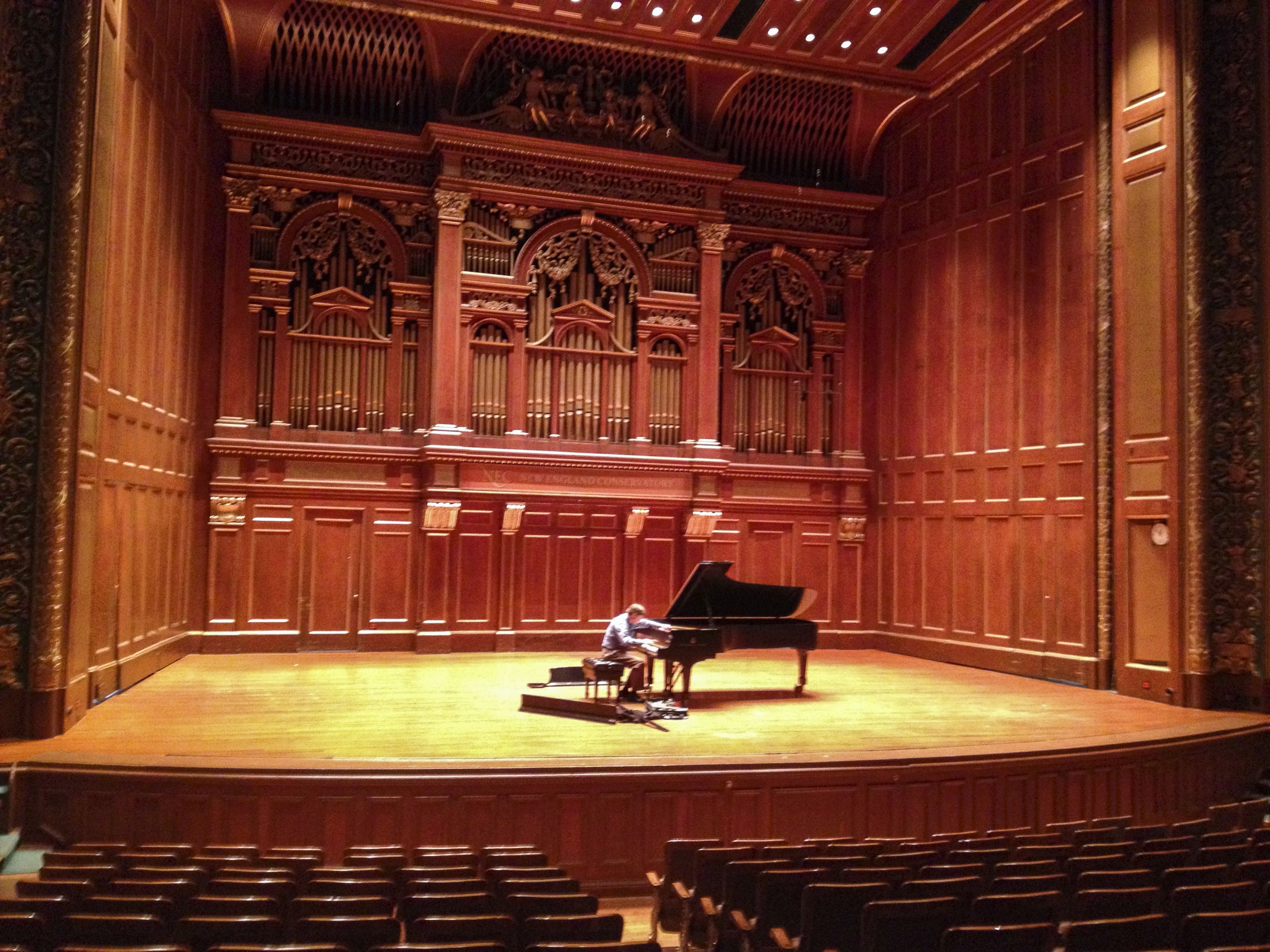Tuning Jordan Hall


by Poncie Rutsch
BU News Service
[soundcloud url=”http://api.soundcloud.com/tracks/111764672″ params=”” width=” 100%” height=”166″ iframe=”true” /]
The faint scent of varnish and dusty carpets greets me when I enter Jordan Hall at the prestigious New England Conservatory on a Friday morning. I carefully lower myself into a chair nestled snugly into a curved row, wondering how the narrow rows can accommodate several hundred people hunting for their seats. The chamber orchestra, comprised of about fifteen students, is rehearsing Honegger’s Symphony Number 2. The deep reds, greens, and golds in the hall reflect the mournful midtones and Honegger’s dark outlook on World War II, when he worked with the French Resistance.
First the violins play an agonizing escape upwards. Short notes ring in the domed ceiling because of their high pitch. The cellos and basses pulse forward as if a cyclone formed within the rounded walls. The storm reaches a feverish whirling, and then comes a release. The rhythm starts to slow as each part plays a countermelody. Finally the violas and cellos pick up the orchestra, humming the melody slowly, as if seeking solace from the cyclone.
Every so often, the players stop to critique one another. A chamber orchestra functions like a large quartet: the group has to communicate through eye contact and cues rather than taking the beat from a conductor’s hand movements. Palma guides the rehearsal, but mostly stands amongst the seats and lets these aspiring professionals take the lead.
The warbled echoes off the hall’s walls are louder than the sound directly from the students’ mouths; from the back row, I can’t understand the students’ garbled voices. I am the only body in the audience this morning, which means the sound ricochets more than usual. Filling the hall with bodies absorbs more direct sound, reducing the sound waves reverberating off the walls.
Jordan Hall appears globe-shaped, with panels arcing high overheard and a thousand chairs arranged in horseshoe-shaped rows. The balcony forms a perfect half circle, with the stage at its diameter. The floor of the hall slopes toward the stage, so that each individual seat has an intimate, unobstructed view. The stage floor is angled at audience, almost like a teacher leaning in to advise her pupils.

Yet the room doesn’t sound like the inside of a globe; curved walls would focus the sound at one seat and throw every other into chaos. Like a lens in a pair of glasses focuses a blurred image at one point inside the eye, a curved wall can both focus and distort music, depending on the location of one’s ear. At the focal point, the music would sound extra loud and perfectly balanced. But all other points would sound unbalanced because the high notes and low notes would reach the listener at different times and volumes. A closer look reveals that only the back wall of the hall is curved.
A perfectly flat surface reflects sound too quickly, making it sharp and harsh. This is why many halls are covered in panels of different sizes; they reflect the music without making it echo like an empty hallway. A panel will reflect only the pitches with wavelengths that are multiples of the panel’s size. Larger panels reflect deeper sounds, while smaller panels reflect higher pitched sounds. Too many same-sized panels placed adjacently will distort the sound, so the ceiling of the hall looks more like a stack of uneven tiles than a geodesic dome.
Every hall can be tuned, just like the instruments on the stage. Many stages have a canopy that can be lowered to dampen the sound or raised to amplify it. The designers of Jordan Hall covered the curved rear wall in a layer of felt because the audience complained the hall sounded too bright after a 1995 renovation.
The Boston Symphony Orchestra played Jordan Hall’s inaugural concert on October 20th, 1903, but hasn’t frequented the establishment much since then. The large orchestra sound overwhelms the small hall, while the shoebox shaped Symphony Hall makes their sound broad and full. At the time that Jordan Hall was constructed, the New England Conservatory was essentially a finishing school, training young women in piano and voice. Jordan Hall was their recital hall, perfect for soloists and small groups. Many esteemed European soloists would stop in Boston on their way to Carnegie Hall, and would choose Jordan over Symphony Hall for its intimacy and robust solo performance sound.
The chamber orchestra completes its rehearsal, and then a tour group comes in, begging their guide to sing for them. He waffles, unsure whether to accept the compliment and sing or to modestly keep quiet. He finally concedes, straightens his shoulders, and fills the hall with a few swelling tenor lines.
When he finishes and herds his group out of the hall once more, there’s a momentary silence. Then the piano tuner comes in to massage the keys for tonight’s performance, and the hall is filled once more with the chromatics of careful tuning.
